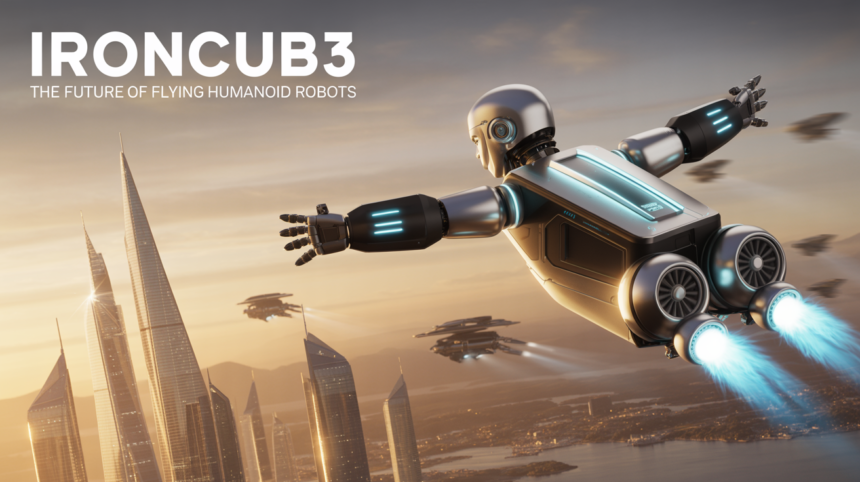Imagine a robot that can not only walk like a human but also fly using jet engines. That’s exactly what the iRonCub3 robot does. Created by the Italian Institute of Technology (IIT), iRonCub3 is the first jet-powered humanoid robot in the world. With the power of AI-powered systems and jet engines, this robot can move like a human and fly through the air. Let’s dive deeper into the exciting technology behind iRonCub3 and what makes it so special.
What Is iRonCub3?
iRonCub3 is a new kind of robot designed to be more like humans. Unlike most robots that are limited to walking or rolling on wheels, iRonCub3 is different. It can fly and walk, thanks to jet engines attached to its body. It has four engines two on its arms and two on its back in a jetpack. These engines help the robot fly and move smoothly.
It was created as an upgrade to the older iCub humanoid robot. The iRonCub3 robot is designed to handle real-world tasks, like flying and walking in challenging situations, which regular robots can’t do.
How Does iRonCub3 Work?
The robot’s design is built around several powerful systems that help it fly and walk with ease. Here’s a breakdown of how iRonCub3 works:
1. Jet Engines for Flight
iRonCub3 has four jet engines two are attached to its arms and two to its jetpack on the back. These engines produce enough force to make the robot fly, similar to how drones work but with more advanced capabilities. These engines can create 1000 N of thrust, allowing the robot to hover and move through the air.
2. AI-Powered Control System
The key feature that allows iRonCub3 to fly smoothly is its AI-powered control system. This system helps the robot stay stable while flying, even when the wind blows or the robot changes direction. The AI controls how the robot moves, keeping it balanced during flight and while walking.
3. Aerodynamics and Stability
Unlike traditional drones that have simple designs, iRonCub3 is built in a humanoid shape. This shape makes it harder to keep stable during flight. To solve this, researchers used advanced aerodynamic models. These models help the robot keep its balance and adjust its flight path in real time, which is a huge challenge for robots with moving limbs.
Why iRonCub3 Is Important
iRonCub3 is more than just a cool invention it’s a step forward for the whole field of robotics. Let’s look at why it’s so important.
1. New Type of Humanoid Robot
Most robots today can only walk or move on wheels. iRonCub3 changes that. It combines both aerial mobility (flying) and terrestrial locomotion (walking). This makes it a new kind of robot that can do things other robots can’t. For example, it could help with tasks in areas where other robots would struggle, like in search-and-rescue missions or hazardous environments.
2. Real-World Applications
One of the biggest advantages of iRonCub3 is its ability to work in the real world. Robots that fly like drones are often limited because they can’t do much beyond flying. iRonCub3, however, can walk, fly, and manipulate objects, making it suitable for complex tasks like inspections in dangerous places or working in disaster-struck areas.
3. A Step Toward the Future
iRonCub3 is not just a fun robot to look at it’s a part of the future of robotics. By combining AI and jet engines, it shows how robots could one day help us in many different ways, from rescue operations to exploration.
The Technology Behind iRonCub3
Let’s take a closer look at the different technologies that make iRonCub3 so impressive:
1. Advanced Aerodynamics
iRonCub3 is not a regular robot. Its humanoid shape means it has to deal with unique challenges in aerodynamics. Most drones are small and compact, but this robot is tall and shaped like a person, which can make it harder to fly. To solve this, researchers used advanced aerodynamic models and wind tunnel tests to study how air flows around the robot.
These tests showed that it’s possible for the robot to stay stable even when its body changes position or when the wind is strong.
2. Heat Management
The jet engines on iRonCub3 produce a lot of heat. The exhaust temperatures can reach up to 800°C, which could damage the robot. To handle this, the team used special heat-resistant materials and designed the robot with a titanium spine to protect it from extreme heat.
3. Real-Time AI Control
What makes iRonCub3 unique is its ability to make real-time decisions while flying. The AI uses neural networks trained on simulated and real-world data to predict and adjust the robot’s flight path. This allows the robot to handle difficult situations, like turbulent air or sudden changes in direction.
The Challenges of Building iRonCub3
Building a robot like iRonCub3 was no easy task. Here are some of the challenges the research team faced:
1. Keeping It Stable in the Air
Humanoid robots, like iRonCub3, are different from drones because they have arms and legs that move. This makes it harder to keep them stable while flying. The team had to come up with advanced flight balance models to make sure the robot could stay stable.
2. Managing Heat from the Jet Engines
The jet engines produce extreme heat. Managing this heat was a major challenge, and the team had to design special parts to keep the robot’s body safe from damage.
3. Real-Time Flight Control
Flying a humanoid robot requires constant adjustments to maintain balance. The team developed a real-time control system that allows iRonCub3 to make these adjustments instantly, ensuring smooth and stable flight.
What’s Next for iRonCub3?
Now that iRonCub3 has successfully taken flight, what comes next? The research team will continue testing the robot, making improvements along the way. Some of the next steps include:
- More Flight Testing: Testing will continue in collaboration with Genoa Airport, where a special flight area will be set up.
- Real-World Applications: The robot will be used in search-and-rescue missions, hazardous environment inspections, and space exploration.
Conclusion: The Future of Robots
iRonCub3 is a huge leap forward in humanoid robotics. Its ability to walk, fly, and perform complex tasks with the help of AI-powered systems and jet engines opens up endless possibilities for robots in the future. This robot could help in dangerous rescue missions, inspect hard-to-reach places, and even explore new frontiers in space.
As the team at IIT continues testing and refining iRonCub3, it’s clear that this robot represents the future of technology and it’s just the beginning. The next generation of humanoid robots is here, and it’s flying.
FAQ
What is iRonCub3?
iRonCub3 is the world’s first jet-powered humanoid robot designed to fly while maintaining a human-like structure. It integrates AI-powered control systems and four jet engines to enable stable flight and movement.
What makes iRonCub3 different from drones?
Unlike traditional drones that have compact, symmetric designs, iRonCub3 has a humanoid form. This makes its aerodynamics and balance much more complex, requiring advanced AI and real-time adjustments.
How does AI help iRonCub3 fly?
The AI-powered systems in iRonCub3 help the robot adjust its flight path, stay balanced, and react to changes in the environment, like wind or movement. This makes its flight smooth and stable.
What are the future applications of iRonCub3?
In the future, iRonCub3 could be used for search-and-rescue missions, environmental inspections, and even space exploration, where both aerial and humanoid capabilities are needed.






